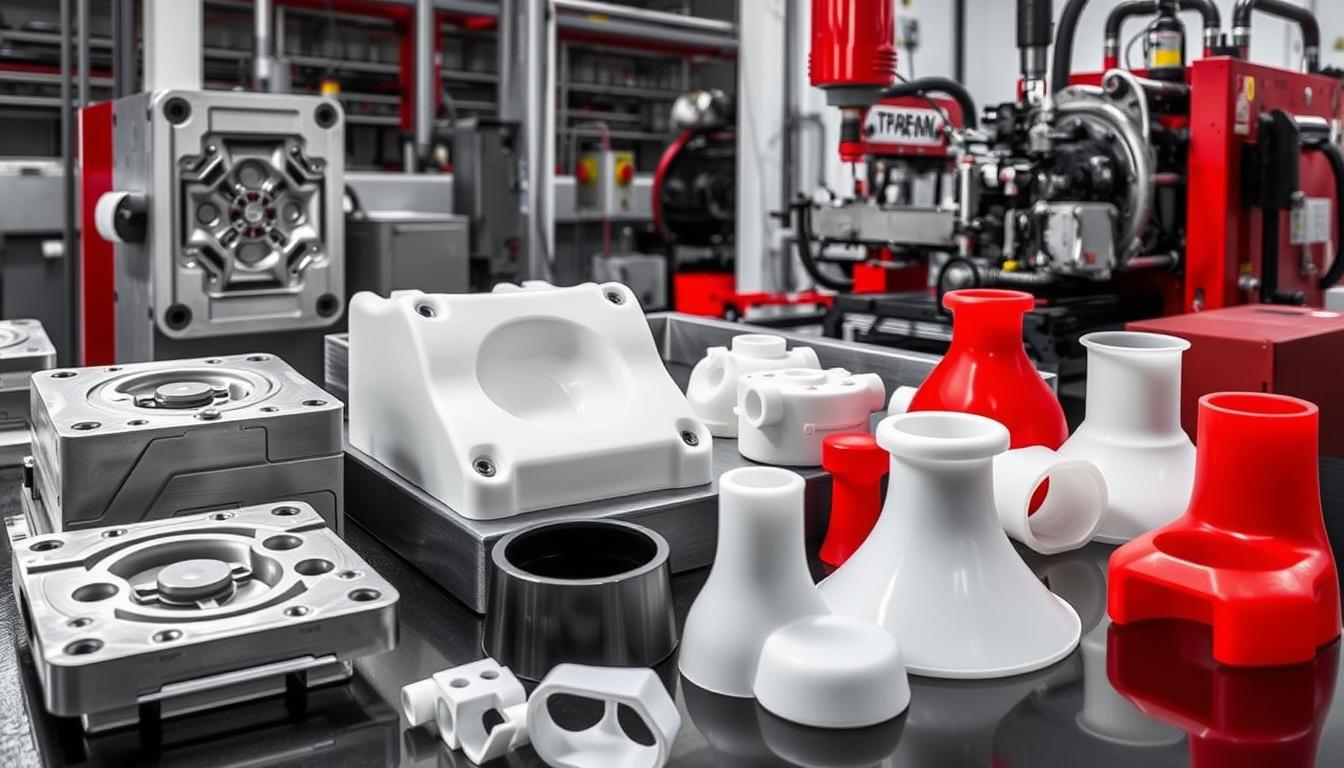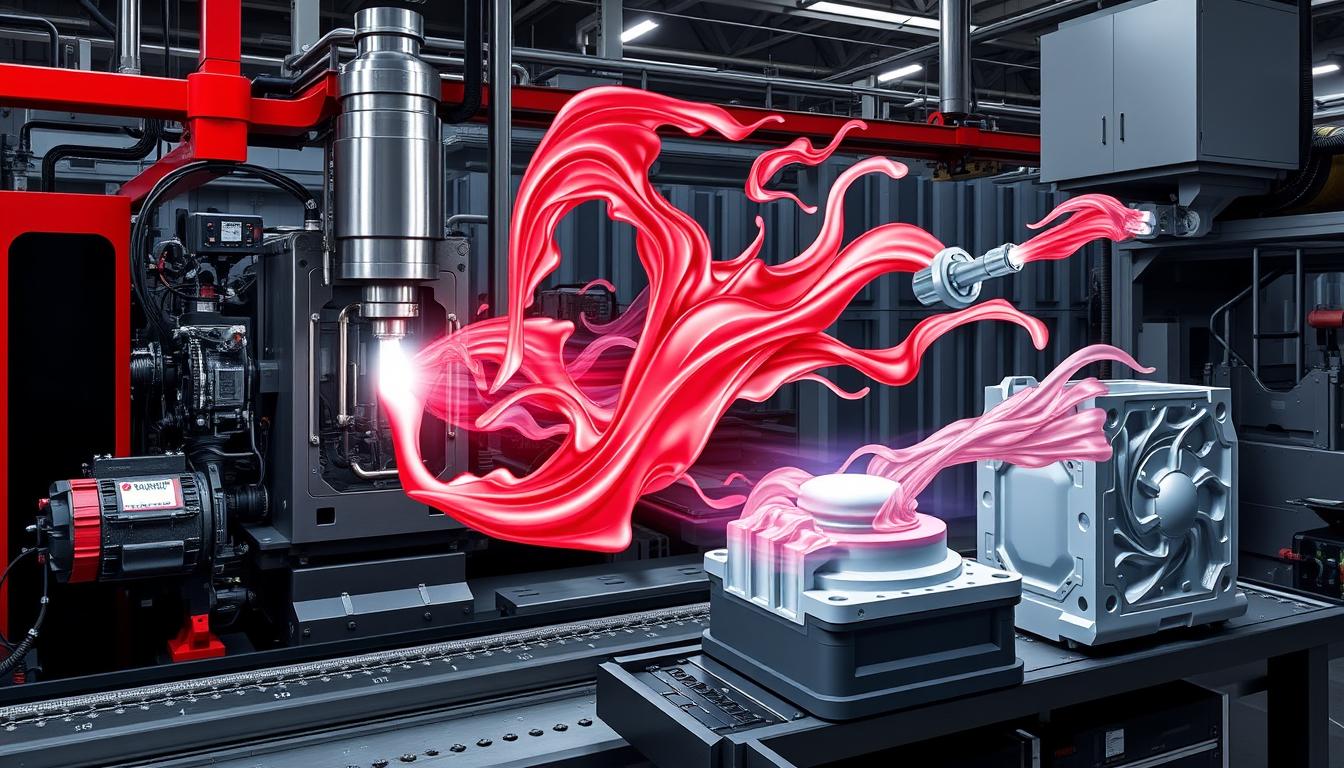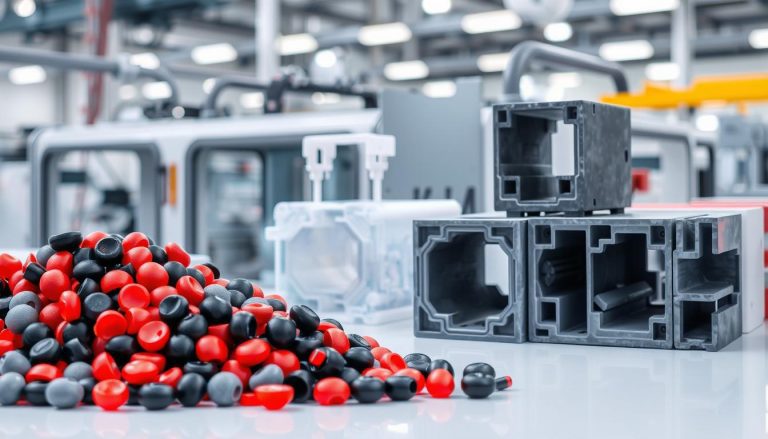We explore the world of perfluoroalkoxy copolymer (PFA) and its advantages in the injection molding process. PFA is popular in many industries. It is highly chemically resistant and can withstand high temperatures, making it perfect for difficult tasks.
We explain the chemical properties and advantages of PFA. The areas of application are also described in detail. This information is great for engineers and technical decision-makers who are looking for new production methods.
Important findings
- PFA offers superior chemical resistance.
- The injection molding process enables efficient processing of PFA.
- The advantages of PFA are its high temperature resistance and versatility.
- PFA is used in electronics and medical technology.
- A comparison with other materials shows the unique properties of PFA.
What is PFA?
PFA, or perfluoroalkoxy copolymer, is an important step in the world of polymer materials. It has a polymer structure that makes it ideal for many industrial purposes.
It is very chemically resistant and has a high temperature stability. These properties make it ideal for the chemical industry and medical technology. Compared to PTFE, PFA is easier to process.
PFA is often used to protect surfaces from aggressive chemicals. Companies value its versatility and reliability, even under high loads.
The chemical properties of perfluoroalkoxy copolymer (PFA)
PFA is in great demand due to its chemical properties. It is resistant to acids, bases and solvents. This makes it perfect for difficult environments.
It can also withstand extreme temperatures. PFA remains stable from -200 °C to +260 °C. This is great for electronics, mechanical engineering and medical technology.
Advantages of PFA in the injection molding process
PFA has many advantages in the injection molding process. It is particularly good for applications where there are high demands on durability and temperature stability. Two important characteristics of PFA are examined in more detail here.
Excellent chemical resistance
PFA is highly resistant to many chemicals. This makes it ideal for difficult environments. It saves time and money because it requires less maintenance.
The durability of PFA components increases enormously. This is a major advantage for projects.
High temperature resistance
PFA can also withstand extreme temperatures. It works from -200 °C to +260 °C. This is perfect for the food and pharmaceutical industries.
The use of PFA in the injection molding process makes it possible to create products that can withstand extreme conditions.
| Property | PFA | Conventional materials |
|---|---|---|
| Chemical resistance | Very high | Variable |
| Temperature range | –200 | °C to +260 °C-50 °C to +150 °C |
| Service life | Long-termShort | to medium-term |
Areas of application for PFA in injection molding
PFA has many applications in injection molding. It is particularly popular in electronics and medical technology. This is due to its unique properties.
Electronics and electrical engineering
In electronics, PFA is often used as an insulating material for cables. It has great electrical insulation and is chemically resistant. This makes it perfect for many applications.
PFA is also used for coating components. This improves the safety and durability of electronic components.
Medical applications
PFA is very important in medical technology. It is biocompatible and can be easily sterilized. This makes it ideal for products that come into contact with biological fluids.
Applications range from catheters to pumps. High safety and hygiene standards are required here.

| Area of application | Advantages of PFA |
|---|---|
| Electronics | High electrical insulation, chemical resistance |
| Medical technology | Biocompatibility, easy sterilizability |
Manufacturing process for PFA products
PFA products are mainly manufactured by injection molding. This method ensures precision and repeatable quality in the production of complex parts. The PFA material is heated until it can melt. It is then injected into special molds.
- High production speed
- Low production costs for large series
- Flexibility in the design process
- Possibility of producing parts with smooth surfaces
The manufacturing processes can be adapted. This means that PFA products can be optimized for different industries. This flexibility helps to offer innovative solutions for PFA products.
| Aspect | Advantage |
|---|---|
| Precision | Exact dimensional accuracy of the parts |
| Repeatability | Constant quality with repeated productions |
| Design flexibility | Adaptation to specific customer requirements |
| Cost | efficiency, especially for large quantities |
The injection molding process is the preferred method for PFA products. It meets modern requirements and offers market-driven solutions. Technical progress is constantly improving the possibilities of PFA production.
Processing techniques in injection molding
The techniques for injection molding PFA are very important. They help to produce high-quality parts. The right machines and methods are necessary for this.
Injection molding of PFA: An overview
Special machines are required for the injection molding of PFA. These must be suitable for the properties of the material. The mold and the heating and cooling parameters are very important.
The quality of the products depends on it. Finding the right parameters is crucial.
Optimization of the injection moulding parameters
Optimizing the injection moulding parameters is very important. It improves the quality and consistency of the PFA components. Adjusting the temperature, pressure and speed makes the process more efficient.
This helps to reduce errors and material waste. It is important to keep testing and adjusting these parameters.

| Parameters | Optimal values Effects | of mismatching |
|---|---|---|
| Temperature | 200-250 ° | CPoor flowability, surface defects |
| Pressure | 500-1000 | barInsufficient filling, formation of air bubbles |
| Injection | speed Fast, but controlled | Crack formation, uneven structure |
Comparison of PFA with other materials
Comparing PFA with other materials is important. It helps us to make the right choice in the industry. The comparison with PTFE and other technical polymers is particularly interesting.
PFA vs. PTFE
PFA and PTFE are both very chemically resistant. But PFA is easier to process. This enables more precise shapes and tight tolerances.
This is why PFA is often chosen when high demands are placed on the accuracy of fit.
PFA vs. other technical polymers
Compared to polypropylene and polyamide, PFA is resistant to temperature and chemicals. These advantages make PFA ideal for special applications in critical industries.
The table below shows the most important differences:
| Property | PFA | PTFEP | olypropylene | Polyamide |
|---|---|---|---|---|
| Chemical | resistance | Excellent | Excellent | Good Sufficient |
| Temperature | resistance | Superior | High | Medium Variable |
| Workability | High | Medium | High | Medium |
| Typical applications | Special applications | General applications | Consumer | goodsTechnical components |
Ecological aspects of PFA
Ecology is becoming increasingly important when using PFA in industry. PFA products are very chemically resistant and last a long time. This means less waste because spare parts are needed less often.
A longer product life cycle increases environmental awareness in the industry. This is good for the environment.
It is important to dispose of PFA products correctly. This is how we protect the environment. Recycling PFA helps to produce in a more environmentally friendly way.
| Aspect | Significance for the ecology |
|---|---|
| Longevity of PFA products Reduces | the need for frequent replacement and reduces waste. |
| Chemical resistance | Minimizes the release of harmful substances into the environment. |
| optionsPromotes | sustainable | practices and reduces the environmental footprint.
| disposalPrevents | environmentalpollution | due to improper disposal.
Ecological aspects of PFA are important for sustainable production. Companies should use PFA and promote environmental awareness. Technical efficiency and ecological responsibility are important.
Conclusion
Perfluoroalkoxy copolymer (PFA) is an excellent choice for injection molding. It is highly resistant to chemicals and heat. This makes PFA very popular in many industries.
It offers many processing options. This results in high-quality products. PFA remains stable even at extreme temperatures.
At [your company], we use PFA for innovative solutions. We adapt our products precisely to the needs of our customers. Our aim is to always offer the best quality.
The injection molding process with PFA is therefore a smart decision. It is ideal for demanding projects.
FAQ
What is PFA and what is it used for?
PFA is a plastic that is very resistant. It is used in electronics, medical technology and chemistry.
What advantages does PFA offer compared to PTFE?
PFA is easier to process than PTFE. This makes the parts more precise and accurate. Both materials are very resistant.
How is PFA processed in the injection molding process?
PFA is produced by injection molding. The material is heated and injected into molds. This produces precise parts.
What are the chemical properties of PFA?
PFA resists acids, bases and solvents very well. It can withstand temperatures from -200 °C to +260 °C. This makes it very useful.
In which areas of application is PFA frequently used?
PFA is used in electronics, medical technology and chemistry. It insulates cables and helps in the production of biocompatible parts.
How are the injection moulding parameters for PFA optimized?
The injection molding parameters are adjusted to improve the quality of the PFA components. These include temperature, pressure and speed.
What are the ecological aspects of PFA?
PFA is durable and resistant. This results in less waste. Nevertheless, proper disposal and recycling is important to protect the environment.





